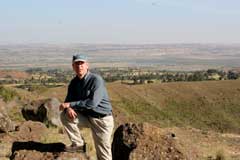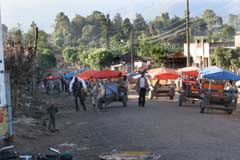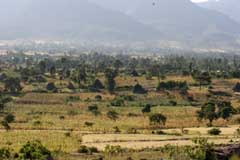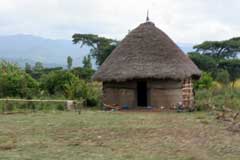Ethiopia
2006
~
Ethiopia background

Ethiopia is an ancient and mystical country situated on the northeastern horn of Africa, with Sudan, Kenya, and Somalia as its major neighbors. It is a land of green highlands, searing deserts and dramatic mountain ranges with deep gorges. Springs near Lake Tana in the northwest are the source of the Blue Nile River. The Great Rift Valley carves the country from northeast to southwest, and the area of Yetebon to which we traveled is located on the western edge of this Valley. Hundreds of species of birds live in Ethiopia and several large national parks are home to many species of animals that roam undisturbed. Since much of Ethiopia is above 6,000 feet most areas enjoy a moderate climate with warm days and cool nights.
Ethiopia was a center of learning, architecture, and trade more than a thousand years before Christ. It is the only African country to have its own alphabet and script. The Orthodox Christian faith was established in the third century A.D. and continues to be practiced unchanged. Today approximately 50% of the population is Orthodox with the remainder split between Muslim (35%) and Protestant (15%) faiths.
Ethiopia is the second most populous country in Africa, with about 80 million people. About 3 to 5 million live in or around the capital (Addis). The remainder live in rural settings - either small towns or smaller villages. In Addis, one encounters a mix of western style living (houses, electricity, indoor plumbing) and pockets of poverty in which these luxuries are not present. In the rural areas, whether in the small towns or the villages, we found only poverty: The endemic nature of these extremely impoverished living conditions was overwhelming.
Outside Addis, there were very few who had electricity, fewer still with anything other than a dirt floor, and even fewer with running water. The vast majority of the population outside Addis lived in conditions of extreme poverty - defined in whatever way you might choose - income, nutrition, access to clean water, level of hygiene, access to medical/dental care, mortality, morbidity. Roads leading to Addis were paved - everything else was dirt. Cars or buses were virtually nonexistent and most people traveled everywhere by foot or on a donkey's back.
The vast fertile land of the Great Rift Valley is tilled, planted, cultivated, and harvested by hand - literally, or behind an oxen pulled plow. A not uncommon sight during our time there (in harvest season) was that of one or two men in an enormous field of wheat, bending low with scythe in hand, alternately cutting and tying bunches of wheat, then placing the tied bunch on a pile that gradually grew as the afternoon progressed. Eventually the pile would be transported on top of their heads to a threshing area where oxen would be driven over the pile of wheat, tramping the pile to separate chaff from the wheat kernels.
Many of the medical problems we saw were a direct result of the fact that many of these people live almost entirely on the crops or animals they can grow or raise on their piece of land. Subsistence farming, as it is called, is a normal way of life in much of rural Ethiopia, yet contributes to poor nutrition, bowel obstruction, and other problems because there is not enough dietary variety to provide all the required nutrients. Also, since water must be transported often long distances into each home by hand or on the back of an animal, dehydration contributes further to poor health.
Another life style issue that contributes to poor health is the choice of housing itself. Most people live in small round mud huts with thatched roofs called tukuls or gojos - picturesque and quaint, to be sure - but very unhealthy. The structure is shared with the family animals, for one thing. At night, the cows, sheep, goats, and chickens are brought into the house, along with all the kids, to sleep under one roof. Also, the structure is heated by an open wood fire which also doubles as a stove for cooking meals - but there is no chimney. As a result, the air inside the house is thick with smoke and soot. Very unhealthy! There are no windows or other ventilation and when the fires are lit in the late afternoon in preparation for the evening cooking and heating, the gojos look for all the world to be on fire, with smoke billowing through their thatched roofs!
The people of the Yetebon area are from the Guraghe people group, one of about 80 groups in Ethiopia. In the clinics which we conducted in nearby areas we also ran into the Tigray and Oromo people. Our translators, proficient in the national language of Amharic as well as English, needed to pull in a third party to help with those patients who spoke only Guraghe, Tigray or Oromo.
Here is another site with info about Ethiopia, Yetebon, and Project Mercy: Info from Barbara Hood






